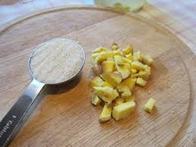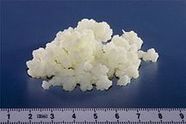I have been more aware of what is on labels especially on yogurt and kefir. It's all a bit confusing when you are reading the labels trying to compare products, to make sure you are getting the best value. I wanted to pass on the information I have discovered in the process. First there is no government standard on the use of the word yogurt or kefir, so the labels are very misleading. There are only industry organizations which are trying to standardize what actually is yogurt or kefir..
My first question was what was the difference between the terms live cultures and active cultures. Some products have live cultures listed on their labels and others have active cultures and some use both terms on their labels. From what I have discovered is the terms are used interchangeably and it means there are live cultures in the product at the time of manufacturing. All yogurt must be made with the bacterial cultures from Lactobacillu bulgaricus and Streptococcus thermophilis. These are the living organisms that turn pasteurized milk into yogurt during a fermentation process.
There are some yogurts that heat treat the product after manufacturing. In heat treated yogurt, these cultures are killed when the yogurt is heated after fermentation. Manufacturers heat treat yogurt products to give them a longer shelf life or to lessen the tart taste of the yogurt. Check the label carefully to make sure the product you are selecting is not heat treated because that's why you are buying yogurt, you want the live cultures to aid in your digestion.
My next question, what was the difference between live cultures and probiotic cultures? Some of the yogurts and kefir claim to have probiotic cultures along with live cultures. It seems that probiotics are a type of live culture. Probiotics are stronger cultures, which are resistant to stomach acid and bile and able to attach to the intestinal wall and colonize the intestinal tract. Live cultures live only in the stomach and never reach the intestines since they are not as strong.
In conclusion look at the label to make sure it has live cultures and probiotic cultures when buying yogurt and kefir. Make sure the product has not been heat treated in order to get the health benefits from it. You will notice most products have only a few live cultures and probiotics listed on their labels. The best option is to make your own kefir if you are interested in getting large quantities of probiotics in your body. You can't bottle real kefir it's alive with active cultures and probiotics, it will explode if it's bottled. Makes you wonder how active are the cultures in yogurt or store bought kefir?
Below is typically what is found in real milk kefir you make yourself
Microbial Composition Of Kefir At The End Of Fermentation [colony forming units/ml]
Lactococci : 1,000,000,000
Leuconostocs : 100,000,000
Lactobacilli : 5,000,000
Yeast : 1,000,000
Acetobacter : 100,000
More information found at Dom's Kefir
My first question was what was the difference between the terms live cultures and active cultures. Some products have live cultures listed on their labels and others have active cultures and some use both terms on their labels. From what I have discovered is the terms are used interchangeably and it means there are live cultures in the product at the time of manufacturing. All yogurt must be made with the bacterial cultures from Lactobacillu bulgaricus and Streptococcus thermophilis. These are the living organisms that turn pasteurized milk into yogurt during a fermentation process.
There are some yogurts that heat treat the product after manufacturing. In heat treated yogurt, these cultures are killed when the yogurt is heated after fermentation. Manufacturers heat treat yogurt products to give them a longer shelf life or to lessen the tart taste of the yogurt. Check the label carefully to make sure the product you are selecting is not heat treated because that's why you are buying yogurt, you want the live cultures to aid in your digestion.
My next question, what was the difference between live cultures and probiotic cultures? Some of the yogurts and kefir claim to have probiotic cultures along with live cultures. It seems that probiotics are a type of live culture. Probiotics are stronger cultures, which are resistant to stomach acid and bile and able to attach to the intestinal wall and colonize the intestinal tract. Live cultures live only in the stomach and never reach the intestines since they are not as strong.
In conclusion look at the label to make sure it has live cultures and probiotic cultures when buying yogurt and kefir. Make sure the product has not been heat treated in order to get the health benefits from it. You will notice most products have only a few live cultures and probiotics listed on their labels. The best option is to make your own kefir if you are interested in getting large quantities of probiotics in your body. You can't bottle real kefir it's alive with active cultures and probiotics, it will explode if it's bottled. Makes you wonder how active are the cultures in yogurt or store bought kefir?
Below is typically what is found in real milk kefir you make yourself
Microbial Composition Of Kefir At The End Of Fermentation [colony forming units/ml]
Lactococci : 1,000,000,000
Leuconostocs : 100,000,000
Lactobacilli : 5,000,000
Yeast : 1,000,000
Acetobacter : 100,000
More information found at Dom's Kefir




 RSS Feed
RSS Feed
